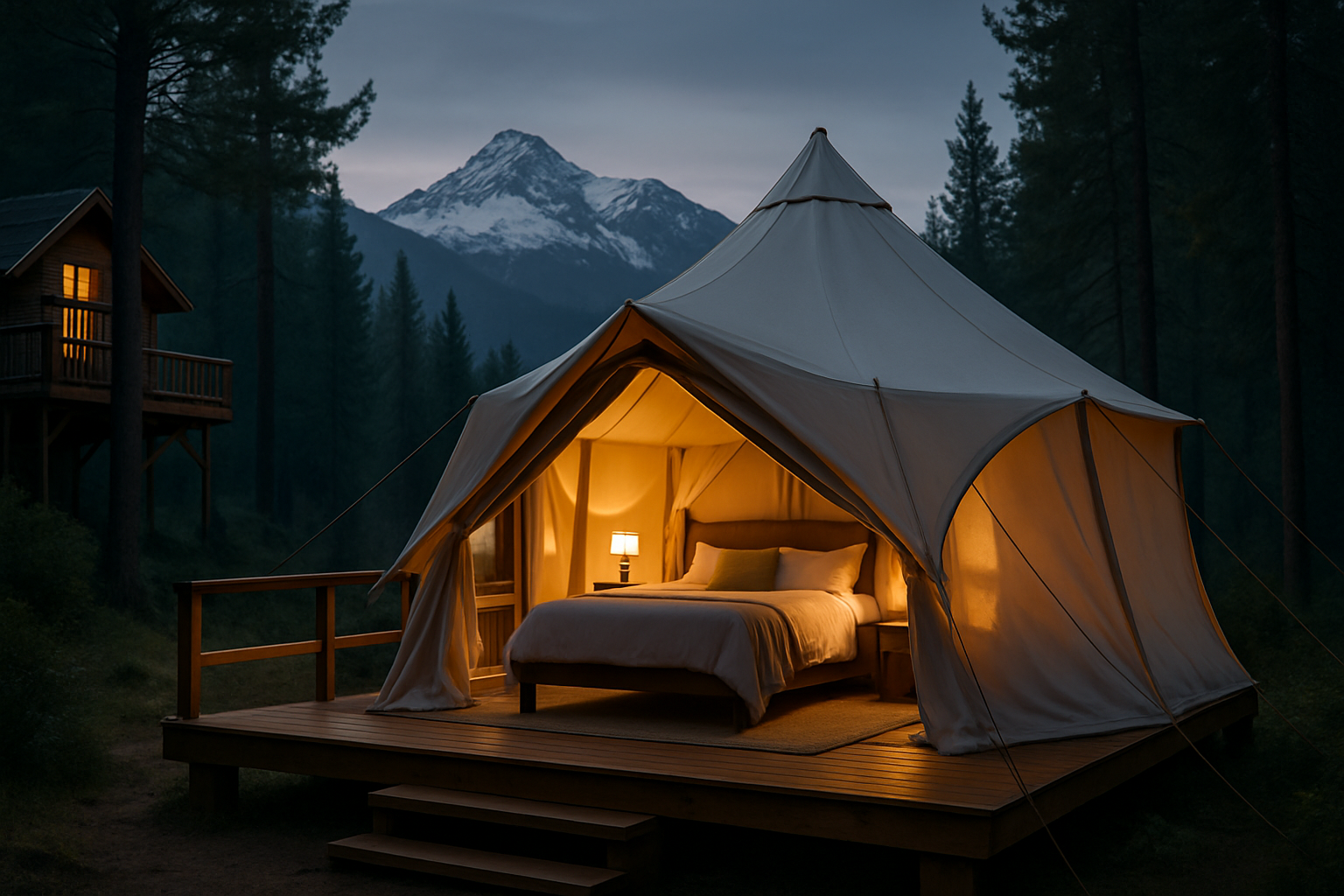No headline found
Glamping—a portmanteau of “glamorous” and “camping”—has redefined what it means to experience the outdoors. This trend combines the immersive natural experience of traditional camping with comforts typically associated with hotels or resorts. Modern glamping accommodations include safari tents, yurts, treehouses, tiny homes, and converted Airstreams, often equipped with proper beds, electricity, heating, and sometimes even air conditioning. These accommodations offer a gateway to nature for travelers who might otherwise avoid camping due to concerns about comfort, convenience, or safety.

The camping industry has undergone a remarkable transformation in recent years. What was once characterized by basic tents, sleeping bags, and cooking over an open fire has evolved into an experience that can include luxury accommodations, gourmet meals, and amenities previously unimaginable in outdoor settings. This evolution reflects changing consumer preferences and a growing desire to experience nature without sacrificing comfort—a phenomenon that has given rise to the glamping movement and reshaped outdoor recreation as we know it.
Modern Glamping: The New Face of Outdoor Adventures
Glamping—glamorous camping—represents a significant departure from traditional camping experiences. Instead of pitching tents and sleeping on the ground, glampers might stay in safari-style canvas tents with real beds, yurts with electricity and heating, treehouses with modern amenities, or even converted Airstream trailers with full kitchens. These accommodations often feature comfortable furniture, quality linens, and design elements that rival boutique hotels.
The appeal of glamping lies in its ability to remove barriers to outdoor experiences. Many people who might be deterred by the physical discomforts of traditional camping—uncomfortable sleeping arrangements, lack of proper bathrooms, or exposure to harsh weather—find glamping to be an attractive alternative. This accessibility has expanded the market for outdoor recreation, bringing new demographics into natural settings who might otherwise never experience them.
The Advantages and Challenges of Glamping
Glamping offers numerous advantages over traditional camping. The most obvious is comfort—proper beds, climate control, and protection from the elements create a more relaxing experience. Many glamping sites also provide amenities like private bathrooms, hot showers, and electricity, eliminating common camping inconveniences. Additionally, glamping often includes curated experiences such as guided nature walks, stargazing sessions, or farm-to-table dining that enhance the connection to the natural environment.
However, glamping isn’t without its challenges. Critics argue that it dilutes the authentic outdoor experience by removing the self-reliance and simplicity that traditional camping encourages. There are also environmental concerns, as some glamping operations require significant infrastructure development in natural areas. From a business perspective, glamping operations face higher startup and maintenance costs than traditional campgrounds, which can translate to higher prices for consumers and potential accessibility issues for lower-income travelers.
The Impact of Glamping on Travelers and the Industry
The rise of glamping has significantly influenced both traveler expectations and the broader tourism industry. For travelers, it has created a new category of experience that bridges the gap between outdoor adventure and luxury accommodation. This has been particularly appealing to millennials and Gen Z travelers who seek unique, Instagram-worthy experiences that combine authenticity with comfort.
For the tourism industry, glamping has opened new revenue streams and business models. Traditional campgrounds have added glamping options to diversify their offerings, while entirely new businesses have emerged to meet the demand. Rural and remote areas that previously had limited tourism potential have found economic opportunities through glamping developments, creating jobs and bringing visitor spending to these communities.
Sustainable Practices in Modern Camping
As camping evolves, sustainability has become increasingly important in both traditional camping and glamping operations. Many modern glamping sites incorporate eco-friendly design elements such as solar power, rainwater collection systems, composting toilets, and locally-sourced building materials. These practices help minimize environmental impact while educating guests about sustainable living.
Some glamping providers have gone further by implementing comprehensive sustainability programs that include wildlife conservation efforts, native plant restoration, and partnerships with local environmental organizations. These initiatives not only reduce the ecological footprint of the operation but also create unique educational opportunities for guests, fostering a deeper connection to and understanding of the natural environment.
The Future of Outdoor Accommodations
The future of outdoor accommodations appears to be heading toward greater diversity and specialization. The glamping market is becoming more segmented, with options ranging from affordable glamping experiences accessible to most travelers to ultra-luxury offerings commanding premium prices. Technology integration is also becoming more common, with some sites offering smart accommodations that allow guests to control lighting, temperature, and entertainment systems through mobile apps.
Another emerging trend is the focus on unique, immersive experiences that go beyond just providing comfortable accommodations. This includes themed glamping sites based on historical periods or cultural traditions, glamping experiences centered around specific activities like astronomy or wildlife viewing, and seasonal offerings that highlight natural phenomena like fall foliage or meteor showers.
The boundaries between traditional hospitality and outdoor accommodation continue to blur, with hotels developing “glamping” options on their properties and glamping operators incorporating more hotel-like services. This convergence suggests that the future of outdoor accommodations will be characterized by hybrid models that combine elements of both worlds to create experiences that resonate with modern travelers’ desires for both comfort and connection to nature.
As the camping industry continues to evolve, it will likely maintain this balance between tradition and innovation. Traditional camping will remain an important part of outdoor recreation, valued for its simplicity and accessibility. At the same time, glamping and other modern approaches to outdoor accommodation will continue to develop, introducing new audiences to the joys of spending time in nature while creating economic opportunities for rural communities and incentives for land conservation.




